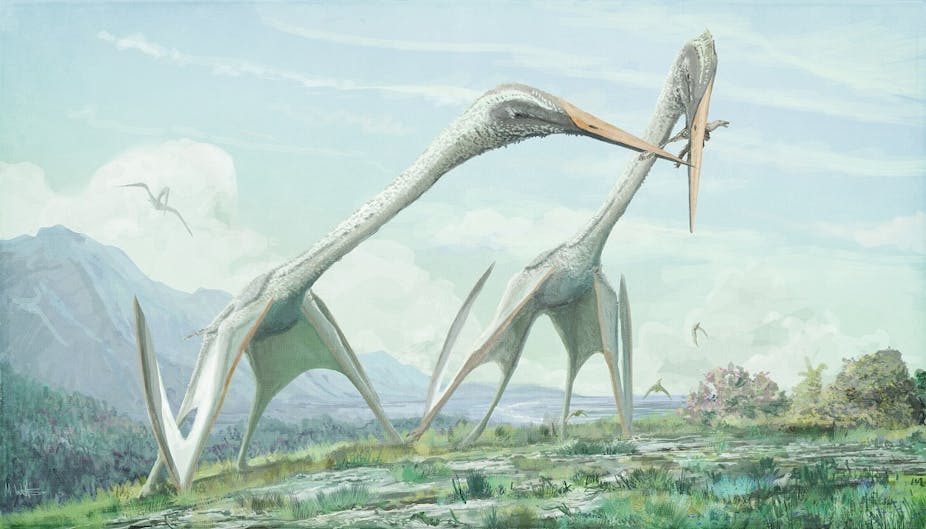Imagine an animal the size of a small airplane flying above your head. This is what you might have seen 70m years ago when giant pterosaurs roamed the skies. These flying reptiles that lived above the dinosaurs’ heads during the Mesozoic era were the largest animals ever to fly. The biggest pterosaurs, giant azhdarchids, had wingspans of between 10 and 11 metres.
But how did these enormous creatures get into the air? The bigger an animal, the harder it becomes for it to fly since more lift is required to counteract its weight so it can take-off. If an animal is too heavy, it won’t be able to produce enough lift to get off the ground. We’d expect an animal the size of a large pterosaur to be too big to fly.

Unlike birds with feathered wings, pterosaurs had a membrane that stretched from the end of an elongated fourth finger to their legs (more similar to a bat than a bird). This membrane had internal structures called actinofibrils to strengthen the wings, and provide structural support. They also had a unique bone in their wrist called the pteroid, which controlled the leading edge of the wing.
Pterosaurs also had a highly specialised respiratory system, similar to that of birds, with air sacs in addition to their lungs. This is a much more effective breathing system, which is important for providing the large amounts of energy needed for flight. Pterosaurs had air sacs in their necks and trunk, and larger creatures also had them in their wings. In many cases, the air sacs invade the bones and hollow them out, making their wing bones extremely thin-walled. This is referred to as skeletal pneumaticity and is another important element contributing to large pterosaurs’ ability to fly.
Unfortunately for us, thin-walled hollow bones are easily crushed and don’t preserve as well as thick-walled marrow-filled bones. So well-preserved pterosaur bones are relatively uncommon. But the small number of 3D pterosaur fossils we do have help us to understand just how hollow these bones were.

How heavy?
Thin-walled hollow bones are important in flight for two reasons. First, they are lighter than bones filled with marrow. Additionally, the bones are more resistant to bending than bones with a smaller diameter and thicker walls and so are better able to deal with the heavy loads created by the pterosaurs’ large size.
We know pterosaurs were the most pneumatised animals to ever live but we still don’t understand how heavy they were. For instance, estimates for the weight of Quetzalcoatlus northropi vary from 75kg to 544kg. This is because their fossils are incomplete and previous studies were based on birds, which isn’t an accurate comparison.
For example, we initially thought that pterosaurs took off by running or jumping. However, recent work has shown that they may have used their powerful forelimbs to launch themselves into the air in a similar way to vampire bats.
My research focuses on using CT scans and X-rays of pterosaur bones to create 3D models of their skeletons. These images allow me to see the internal structure of the bones, which improves our understanding of the distribution of mass and the thickness of the bones.
The goal is to determine which methods are better for determining how heavy these flying giants were. So far, we’ve found that pterosaur bones were heavier than previously thought, and that methods based on working out the volume of the body are more accurate than comparing them to modern animals. Several recent estimates put Quetzalcoatlus northropi at approximately 250kg.
Palaeontologists still have many questions about giant pterosaur flight. We don’t fully understand how they took off or what kind of flyers they were once in the air. Did they flap or soar? How long could they fly for? How did they land? In fact, some people still believe these giraffe-sized animals were too heavy to fly at all. But then what did they do with their wings? These are all questions that new techniques and fossil finds are starting to answer.

